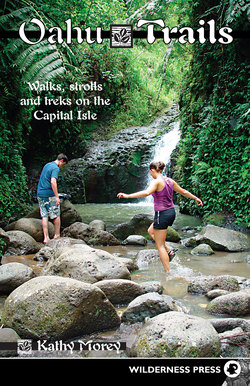Читать книгу Oahu Trails - Kathy Morey - Страница 11
На сайте Литреса книга снята с продажи.
ОглавлениеHiking on the Capital Isle
The search for the perfect trail guide
I wish I could be certain this was a flawless book. However, some things limit an author’s ability to produce a perfect, error-free, always up-to-date book. Here are some of the factors, and what you can do to help yourself (and me).
Nature makes constant revisions; so do agencies and landowners. Nature constantly reshapes the landscape across which we plan to trek. It’s usually a gradual process, but once in a while she makes drastic changes overnight. A landslide, a volcanic eruption, or a hurricane can erase a trail in seconds. Erosion can undercut a cliff edge and make last year’s safe hike an extremely dangerous one, so that the local authorities close a trail you’d hoped to ramble on. And Hawaii’s fragile volcanic terrain erodes quite rapidly.
Agencies in charge of hiking areas may close an area because they’ve realized it’s environmentally too sensitive to withstand more human visits. An area once open to overnight camping may become a day-use-only area. Trails become impassable from lack of maintenance. Happily, agencies may open new areas because they’ve been able to acquire new acreage or complete a trail-building project.
Landowners change; so does land usage. A landowner who has not previously objected to public use of a trail on his land may change his mind or sell to someone else who posts it off-limits. Development may cut off public access to a trail. Or a reexamination of boundaries may reveal that a trail long thought to be on public land is in fact on private property, and the trail may be closed off and abandoned.
Change is the only thing that’s constant in this world, so that guidebook authors and publishers always play “catch up” with Nature and with agencies. We want to keep the guidebooks up to date, but we are always at least one step behind the latest changes. The day when you’ll have constantly revised books online at your wristwatch/computer terminal isn’t here yet. So it’s possible that a few trail descriptions are becoming obsolete even as this book goes to press.
Get the latest official information
It’s a good idea to use this book in conjunction with the latest information from the agency in charge of the areas you plan to hike in. The principal statewide agency in charge of areas that offer hiking opportunities is the Department of Land and Natural Resources (DLNR), particularly two of its subordinate branches: the Division of Forestry and Wildlife, and the Division of State Parks. Each of these branches has a subdistrict for each island.
For the DLNR, write, call, or visit:
1151 Punchbowl St., Room 130
Honolulu, Hawaii 96813
(808) 587-0405, FAX (808) 587-0390
www.state.hi.us/dlnr/Welcome.html
For the Division of Forestry and Wildlife, write, call, or visit:
1151 Punchbowl St., Room 325
Honolulu, Hawaii 96813
(808) 587-0166, FAX (808) 587-0160
www.dofaw.net
For the Division of State Parks, write, call, or visit:
1151 Punchbowl St., Room 310
Honolulu, Hawaii 96813
(808) 587-0300, FAX (808) 587-0311
www.hawaii.gov/dlnr/dsp/index.html
Another excellent source of information is the “umbrella” group of hiking organizations and related government agencies, Na Ala Hele (“The Ways to Go”). You’ll find overview maps and driving directions to many, though not all, of the trips in this book on their website (www.hawaiitrails.org) as well as a list of licensed hiking guides for each listed trail, if there are guides for that trail.
Get current contacts for each area from Na Ala Hele’s excellent website, www.hawaiitrails.org.
Sunbathers enjoy the beautiful beach at Waimea Bay.
Getting permits and permission
Only one hike in this book requires that you have a permit: Trip 37, the Kuaokala Loop. You get the initial permit in person from the Division of Forestry and Wildlife in downtown Honolulu (see address) and exchange it for a military-issued permit at the guard station you must pass.
For visitors from the mainland, there are no backpacking opportunities to speak of on Oahu, so getting overnight permits for backcountry camping doesn’t apply to this book. (What little “backcountry” camping there is is for hunters.)
You will need permits for car camping and cabins; see Appendix A.
Prepare yourself with general information, too
A generous source of a wide variety of useful information about Hawaii is the Hawaii Visitors and Convention Bureau at www.gohawaii.com. For Oahu in particular, see www.visit-oahu.com or call them at (877) 525-6248 (OAHU).
Another good source of general information is a reputable and up-to-date guidebook. Check online or with your favorite travel store for guidebooks to Hawaii, which are too numerous to list here and of which, in any case, I’ve used only a few, especially Moon Publications’ Hawaii Handbook: The All-Island Guide by J.D. Bisignani.
I hope this book helps make your visit to Hawaii even more enjoyable than it would have been. I plan to update it regularly, and you can help me. Your feedback is valuable! Let me know what you think and what you find. Did you find it helpful when you visited Oahu? Was it accurate and complete enough that you enjoyed the walks and hikes you took based on the book? Did you notice any significant discrepancies between this book and what you found when you visited Oahu, discrepancies that you judge are not just the result of two different perceptions of the same thing? What were they? The publisher and I are very concerned about accuracy. I find readers’ comments very helpful in planning my next scouting trip. We’d appreciate your comments. I’d also like to know about it if you think there are ways in which the book can be improved. Write to me in care of Wilderness Press, 1200 Fifth St., Berkeley, California 94710, or email: mail@wildernesspress.com.
Ready for a break from hiking? Try exploring the tidepools on Oahu’s beautiful North Shore.
